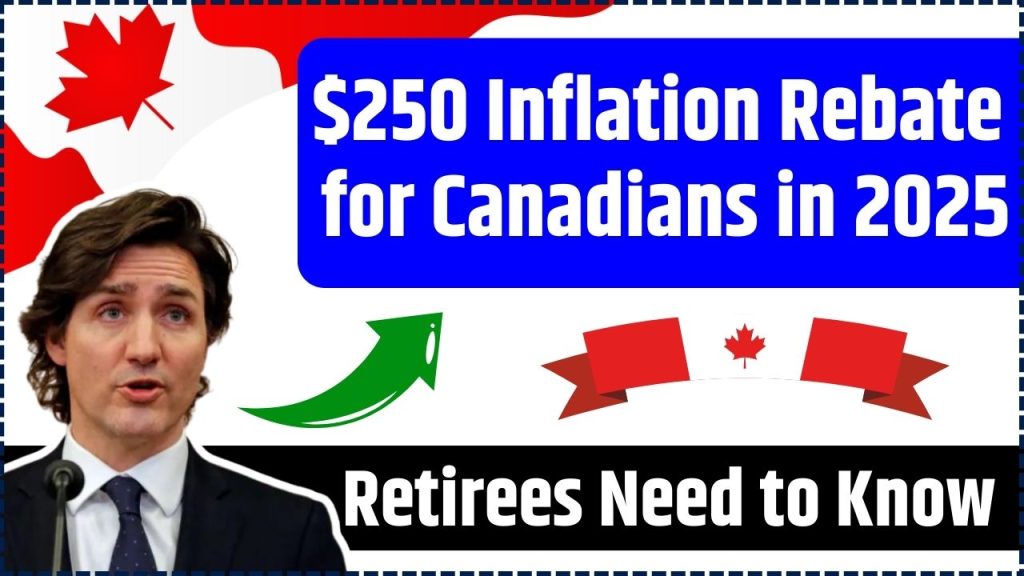
$250 Inflation Rebate for Canadians in 2025: As inflation continues to impact the cost of living in Canada, the federal government has rolled out the $250 Inflation Rebate as part of its 2025 relief measures. This one-time, tax-free payment is designed to help employed Canadians offset rising expenses. However, retirees and those on fixed incomes may find themselves excluded from this particular initiative, raising questions about other available supports.
This article will provide a detailed explanation of the $250 Inflation Rebate, including eligibility criteria, the distribution process, and alternative support measures for retirees. By breaking it down step by step, we aim to ensure everyone understands their options.
$250 Inflation Rebate for Canadians in 2025
| Feature | Details |
|---|---|
| Rebate Amount | $250 |
| Eligibility | Employed/self-employed in 2023 with net income ≤ $150,000 |
| Distribution Date | Early spring 2025 |
| Residency Requirement | Must reside in Canada as of March 31, 2025 |
| Ineligibility for Retirees | Retirees not employed in 2023 are excluded |
| Other Support Measures | OAS increase for seniors aged 75+, other provincial and federal aid |
| Official Resource | Canada Inflation Rebate Details |
The $250 Inflation Rebate is a targeted relief initiative designed to support employed Canadians navigating rising living costs. While retirees are excluded, other government programs like OAS, GIS, and provincial subsidies ensure financial assistance is still available for seniors. Understanding eligibility requirements, filing taxes on time, and exploring alternative supports are key steps to securing the help you need.
What Is the $250 Inflation Rebate?
The $250 Inflation Rebate is a targeted financial relief program introduced by the federal government to assist working Canadians. It acknowledges the strain inflation has placed on household budgets, especially for essentials like food, transportation, and utilities. For those who meet the eligibility criteria, this rebate offers a small but meaningful buffer against rising costs.
Unlike tax credits, the Inflation Rebate is a direct cash payment and is tax-free, meaning recipients won’t have to report it as income. It’s a straightforward way to provide immediate relief to individuals who meet the program’s requirements.
Who Is Eligible for the $250 Inflation Rebate?
To qualify for the $250 Inflation Rebate, individuals must satisfy several conditions:
1. Employment in 2023
- You must have been employed or self-employed during the 2023 calendar year.
2. Income Threshold
- Your net income for 2023 must not exceed $150,000. This includes all income sources, such as employment, self-employment, and taxable benefits.
3. Tax Filing
- You need to file your 2023 T1 Income Tax and Benefit Return by December 31, 2024. To qualify:
- You must have reported contributions to the Canada Pension Plan (CPP) or Quebec Pension Plan (QPP).
- You must have reported premiums paid for Employment Insurance (EI) or Quebec Parental Insurance Plan (QPIP).
- Self-employed individuals must report equivalent contributions.
4. Residency Requirement
- You must be a resident of Canada as of March 31, 2025.
5. Alive and Eligible
- You must be alive and not incarcerated for more than 90 days prior to April 1, 2025.
Why Are Retirees Excluded?
The exclusion of retirees has been a contentious issue since the announcement of the $250 Inflation Rebate. While working Canadians benefit from this measure, retirees who were not employed in 2023 are explicitly excluded. This decision stems from the program’s primary focus: alleviating inflation’s impact on workers dealing with employment-related expenses.
Many advocacy groups for seniors have argued that retirees face similar inflationary pressures, particularly as they contend with rising costs on fixed incomes. However, government officials emphasize that other programs, such as enhanced Old Age Security (OAS) benefits, are designed to provide relief to retirees and seniors.
How Will the Rebate Be Distributed?
Automatic Payment
The $250 Inflation Rebate will be issued automatically to eligible Canadians in early spring 2025. There’s no need to submit a separate application as long as you meet the eligibility requirements and file your 2023 tax return on time.
Delivery Methods
- Direct Deposit: If your banking information is registered with the Canada Revenue Agency (CRA), the payment will be deposited directly into your account.
- Cheque: For individuals without direct deposit set up, a cheque will be mailed to the address on file with the CRA.
Timeline
- Payments are expected to be completed by April 2025. Delays may occur if there are discrepancies in tax filings or residency records.
Canada OAS January 2025: Check Old Age Pension Payment Schedule and Eligibility
Canada GST Payment Update 2025: Check the Next Extra Payment Date, Amount
$3,500, $1,600, $1,100 CPP Benefits for January 2025: Only these people will get it
Additional Government Support for Retirees
Retirees excluded from the $250 Inflation Rebate can still access a variety of government programs aimed at alleviating financial challenges. Here are some noteworthy options:
1. Old Age Security (OAS)
- 10% Increase for Seniors Aged 75+: Seniors aged 75 and older have seen a 10% boost in their monthly OAS payments since 2024. This enhancement helps cover additional living costs.
- Eligibility: Available to individuals aged 65+ who meet residency requirements.
- Maximum Monthly Benefit (2025): Approximately $700, depending on income and residency.
2. Guaranteed Income Supplement (GIS)
- GIS is a supplementary benefit available to low-income seniors receiving OAS.
- Income Thresholds: Single seniors earning less than approximately $20,000 annually may qualify for the maximum benefit.
3. Provincial Programs
- Many provinces offer additional relief to seniors, including:
- Housing Subsidies: Assistance with rent or property taxes.
- Utility Rebates: Discounts on energy bills.
- Pharmacare Programs: Reduced prescription drug costs.
4. Canada Pension Plan (CPP)
- CPP benefits are indexed annually to reflect inflation, providing incremental increases to monthly payments for retirees.
- Maximum Monthly Benefit (2025): Approximately $1,300, depending on contributions.
FAQs On $250 Inflation Rebate for Canadians in 2025
1. Do retirees qualify for the $250 Inflation Rebate?
No. Retirees who were not employed in 2023 are ineligible. However, retirees may qualify for other benefits, such as OAS and GIS, to help manage financial challenges.
2. How do I know if I’m eligible for the rebate?
Eligibility is determined based on your 2023 income tax return. Ensure you meet the criteria for income, employment, and residency to receive the rebate automatically.
3. When will the rebate be paid?
The rebate will be distributed in early spring 2025, with most payments completed by April 2025.
4. What if I forgot to file my 2023 taxes?
You must file your 2023 taxes by December 31, 2024 to qualify for the rebate. Late filings may result in ineligibility.
5. Are there similar rebates in other provinces?
Yes, some provinces offer inflation-related rebates or tax credits. For instance, Alberta has implemented energy rebates, while Quebec offers senior-specific housing assistance.

